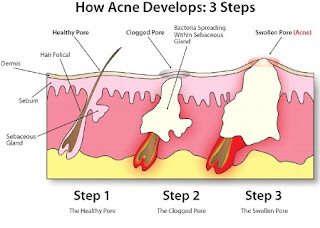Acne Vulgaris - What is it?
Acne vulgaris
(sometimes called “acne”, "pimples", "spots" or
"zits") is a skin problem that happen when oil and dead skin cells clog up the pores. It can be in the form of
comedones, papules, pustules, nodules,
and/or cysts.
SYMPTOMPS
Acne mostly affects skin
with a greater number of oil glands including the face, upper part of the chest, and back. and sometimes even
more extensively over the body.
Some people call acne as blackheads, blemishes, whiteheads,
pimples, or zits.
 |
| image credit : askdrmakkar.com |
CAUSES
PUBERTY
It most often affects adolescent,
it is the most common skin disease in the world and affects the majority of the
people at some point in life, mostly
during puberty. During puberty,
androgen stimulate sebum production
and unconrtolled proliferation of
keratinocytes.
Acne is very common among teens. It
usually gets better after the teenage
years. Some women who never had acne growing
up will have it as an adult, often right before their menstrual periods.
People
may also be affected after puberty
(though it becomes less common in adulthood), nearly half of people in their
twenties and thirties continue to have acne.
HORMONE
Acne
is often brought on by an increase in androgens such as testosterone. Its often
involved excessive growth of the bacteria Propionibacterium
acnes, which is normally present on the skin.
COSMETICS
Using
oil-based skin products or cosmetics can
make acne worse. Use skin products that don't clog your pores. They will
say "noncomedogenic" on the label.
TYPES OF ACNE
Acne is classified by severity as mild, moderate, or
severe, This type of categorization can be an important factor in determining
the appropriate treatment regimen.
Mild acne is classically defined as open (blackheads) and
closed limited to the face with
occasional inflammatory lesion.
Moderate severity is when a higher number of inflammatory papules and pustules occur on the face
compared to mild cases of acne and acne lesions also occur on the trunk of the
body.
Severe acne can mean hundreds of pimples that can cover the
face, neck, chest, and back. Or it
can be bigger, solid, red lumps that are
painful (cysts).
 |
DIAGNOSIS AND TREAMENT
Diagnosis is by examination, Examination
in patients with acne vulgaris includes the following features:
- Comedonal acne: Presence of open and closed comedones but no inflammatory (papules or nodules).Mild acne: Presence of comedones and a few papulopustule
- Moderate acne: Presence of comedones, inflammatory papules, and pustules; reater number of lesions than in milde acne .
- Nodulocystic acne: Presence of comedones, inflammatory lesions, and large nodules, scarring is often evident.
- Treatment for mild acne includes topical anti-acne preparations, lasers and lights
- Treatment for moderate acne adds acne antibiotics such as tetracyclines and/or antiandrogens such as birth control pil.
- Treatment for severe acne may require a course of oral isotretinoin.
·
PREVENTION
To help control acne, keep your skin clean. Avoid skin products that clog your pores. Wash
your skin once or twice a day
with a gentle soap or acne wash. Try
not to scrub or pick at your pimples.
This can make them worse and can cause
scars.
____________________________________________________________
References:
https://en.wikipedia.org/wiki/Acne_vulgaris
http://emedicine.medscape.com/article/1069804-overview
http://www.merckmanuals.com/professional/dermatologic-disorders/acne-and-related-disorders/acne-vulgaris
http://www.webmd.com/skin-problems-and-treatments/acne/acne-vulgaris-topic-overview
http://www.dermnetnz.org/acne/acne-vulgaris.html
0 comments:
Post a Comment